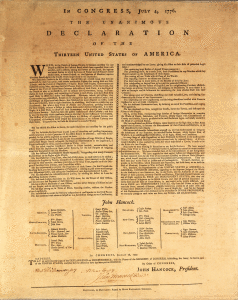
…We hold these truths to be self-evident, that all men are created equal, that they are endowed by their Creator with certain unalienable Rights, that among these are Life, Liberty, and the pursuit of Happiness. That to secure these rights, Governments are instituted among Men, deriving their just powers from the consent of the governed.
On July 2, 1776 the Second Continental Congress officially declared its freedom from Great Britain. On July 4 the Congress approved the Declaration of Independence and sent it to John Dunlap to be printed.
Thomas Jefferson, the main author, had input from John Adams, Roger Sherman, Robert Livingston, and Benjamin Franklin. On August 2 many members began to sign the Declaration.
The Declaration of Independence stated that the King was a tyrant, “unfit to be the ruler of a free people.” It was not only the right of the colonies, but “their duty, to throw off such Government.”
Under Indictment, the Declaration listed a “long train of abuses” and “repeated injuries” of the King of Great Britain, which included: imposing taxes without their consent; often depriving them of the benefit of Trial by Jury; taking “away their Charters; abolishing their most valuable Laws; and altering fundamentally the Forms of our Governments.”
At every stage the colonies had humbly petitioned to correct the situation but the other side had “been deaf to the voice of justice…We must, therefore, acquiesce in the necessity, which denounces our Separation, and hold them, as we hold the rest of mankind, Enemies in War, in Peace Friends.”
Mary Katherine Goddard
Mary Katherine Goddard, at the request of the Continental Congress, printed the second authentic copy of the Declaration of Independence on January 18, 1777. Though Mary Katherine’s was the second printing, it was the first printing to include (all but one of) the typeset names of the signers. Mary took a risk in printing the document, as the British would consider it treason.
Mary, Baltimore’s first Postmaster (appointed by Benjamin Franklin), also published (initially with her brother) Baltimore’s first weekly newspaper, the Maryland Journal and Baltimore Advertiser. Mary continued to print the Maryland paper throughout the War, sometimes paying post-riders with her own money.
There is much more to Mary’s story. An amazing woman, Mary (and her mother) deserve their own book.—constitutioncenter.org, “On This Day,” Scott Bomboy, August 2, 2019; guides.loc.gov; prologue.blogs.archives.gov, Samantha Payne, “Changing the Boundaries,” January 29, 2015.







